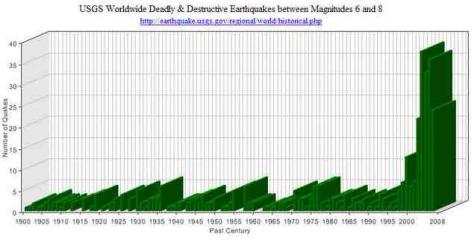The intensity of the earthquakes as well as the frequency has increased . This year alone we had over 4 major earthquakes with significant loss of life . The Haiti earthquake and the Tsunami of 2004 were incredible tragedies that have no precedence for over 200 years since the Krakotoa Eruption and earthquake and the Great Lisbon earthquake.
In 1997 there were only 3 notable quakes. neic.usgs.gov...
1998 saw 10 notable quakes. neic.usgs.gov...
In 1999 there were 13 notable quakes: neic.usgs.gov...
In 2000 there were 6 notable earthquakes. neic.usgs.gov...
In 2001 the number increased to 7. neic.usgs.gov...
By 2002 we jumped to 12 notable quakes. neic.usgs.gov...
Hold on, because in 2003 it was 39 notable quakes. neic.usgs.gov...
2004 calmed to just 39! neic.usgs.gov...
The intensity of the earthquakes as well as the frequency has increased . This year alone we had over 4 major earthquakes with significant loss of life . The Haiti earthquake and the Tsunami of 2004 were incredible tragedies that have no precedence for over 200 years since the Krakotoa earthquake and the Lisbon earthquake.
In 1997 there were only 3 notable quakes. neic.usgs.gov...
1998 saw 10 notable quakes. neic.usgs.gov...
In 1999 there were 13 notable quakes: neic.usgs.gov...
In 2000 there were 6 notable earthquakes. neic.usgs.gov...
In 2001 the number increased to 7. neic.usgs.gov...
By 2002 we jumped to 12 notable quakes. neic.usgs.gov...
Hold on, because in 2003 it was 39 notable quakes. neic.usgs.gov...
2004 calmed to just 39! neic.usgs.gov...
Since 2004 there have been an incredible increase . . Ones that come to mind are the Pakistan earthquake. Sichuan China, Italy, Afghanistan , Iran, Tsunami Aceh and many many others.
Please click on graph below to see this from the Us government showing the proof . Tom Aliki I suggest you show the contrary.
http://www.scientificblogging.com/florilegium/blog/why_so_many_earthquakes_decade
While Haiti is still sorting out the chaos from its January earthquake, the Earth suffers another massive quake in Chile. At a magnitude of 8.8 on the Richter scale this is one of the most powerful earthquakes ever recorded. Concerns about a tsunami spreading across the Pacific have abated and the Chilean authorities claim they have the resources to handle the catastrophe.
Why are we having so many earthquakes recently? Is it just that the media likes to report dramatic and tragic events, or has there been a quantitative increase? The graph below tells a worrying story.
The graph is compiled from data from the US Geological Survey (USGS), which monitors earthquakes throughout the globe. The data goes back over 100 years and looks as if this was compiled in 2007 or 2008. The URL which it points to has worldwide data on earthquakes but no longer has a graphical representation. Perhaps the graph is so alarming the USGS decided not to show data in this way. Just to fill in the recent data: 2008 saw 35 earthquakes of magnitude 6 and over; and 2009 saw a record-breaking 52, taking it way off the above scale - you can go count them yourself!
This alarming increase seems to have started in 1999. The conspiracy theorists have been all over this like a rash and numerous fingers are pointing to HAARP technology. There is increasing evidence that HAARP technology can alter the weather, but can it cause earthquakes? Even the official literature states that starting in 1996 HAARP tested its capabilities for geological mapping using ELF waves by modulating the ambient current in the ionosphere using HF radio waves. The official HAARP website has some interesting simulations of the fields created in the Earth's ionosphere-magnetosphere. Weather modification is another hornet's nest so I'd like to keep this to earthquakes.
However, this isn't a conspiracy website, so are there any scientists in this field who can explain this huge spike in earthquakes? An artefact of more measuring stations, surely not?
We are four months into 2010 and the earthquake season will become very worse if you judge the amount of volcanoes coming to life from Iceland, Japan, Chile, Italy and others. These volcanoes have been dormant for centuries and now they are reawakening.




